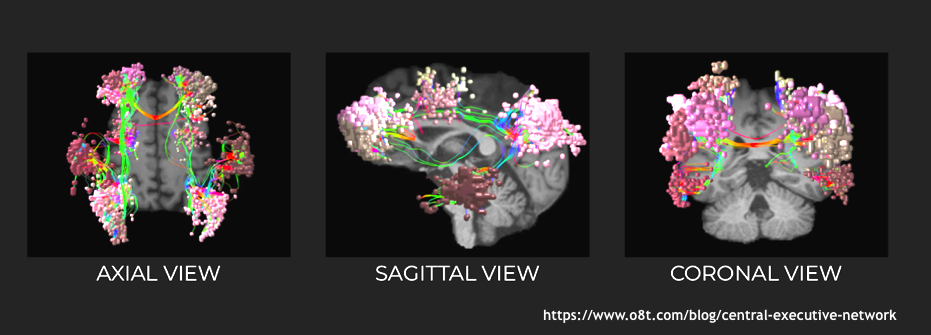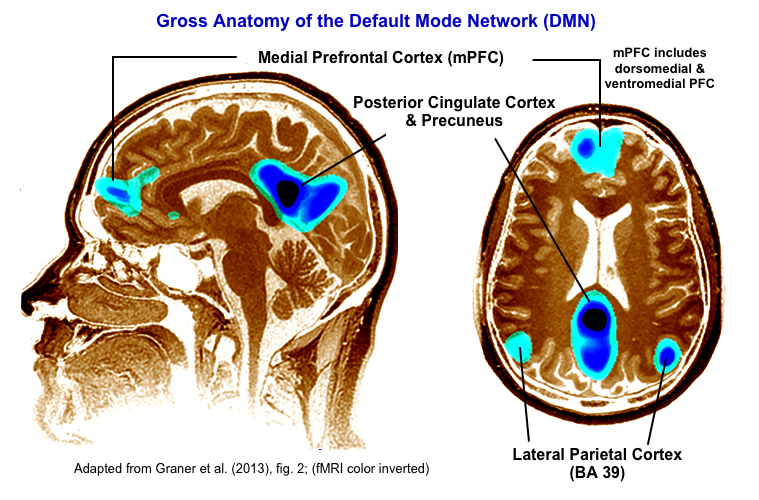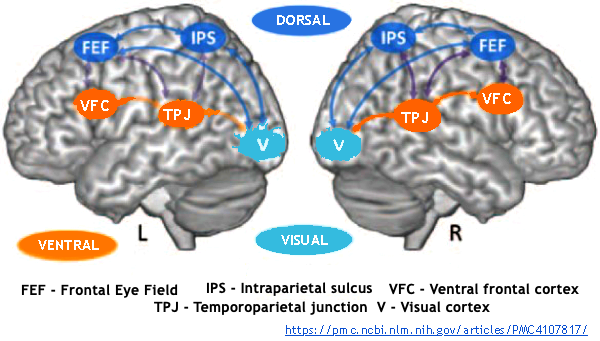Feb 13, 2025
![[Brain Image]](../graphics/head_space.gif)
PSY 340 Brain and Behavior
Class 14: Large-Scale Brain Networks OUTLINE
|
Feb 13, 2025 |
PSY 340 Brain and Behavior Class 14: Large-Scale Brain Networks OUTLINE |
|
Large-Scale Networks of the Brain
Research Methods to Identify Networks
2. DTI (Diffusion Tensor Imaging) aka Diffusion MRI
Rather than concentrating on oxygen and the BOLD signal (as in fMRI), Diffusion Tensor Imaging (DTI) focuses upon molecules of water (H2O) and how water flows through various forms of brain tissue (note that DTI is also used to study other organs of the body).
Depending on whether they are constrained by barriers or not, water molecules can flow or diffuse
- either equally in all directions (= isotropy [iso = equal; tropy = turning]) or
- in an unequal set of directions (= anisotropy [an = not]). See diagram at left
DTI looks at the specific direction for the movement (or their "fractional anisotropy") for water molecules. Since water molecules are most frequently found in the white matter of the brain, DTI can map what the predominant direction (on the X, Y, & Z axis) as H2O diffuses.
When a DTI study is done, each of the major directions can be color-coded so that fibers of tissue that form tracts going in a particular direction (e.g., from the bottom to the top at a 45º angle) can be visualized easily compared to tracts going in other directions. See the examples below (Figs. B, C, & D).
- The study of the differing tracks of white matter fibers in the brain is known as tractography.

Large
Scale Brain Networks
A large scale brain network is a set of connections among various locations (neural bodies) inside the cerebrum. There are two basic kinds of connections in the brain: structural connections and functional connections. How do they differ?
Structural Connections
Functional-Dynamic Connections
There is disagreement over how many major networks function in the brain. The list below indicates 7 networks that many researchers have come to regard as quite important (Sughrue, 2022).

 Default Mode
Network (DMN): Sometimes called the "Task-Negative
Network"
Default Mode
Network (DMN): Sometimes called the "Task-Negative
Network"(1) Daydreaming & other forms of "spontaneous thinking"
(2) Considering one's own present mental state; self-referential or "introspective" thinking; one's own internal narrative (internal talk); internally-directed thought
(3) Reflecting on "the autobiographical self" and dealing with autobiographical memories
(4) Episodic memory and future thinking; decision making about the future, i.e., recalling the past and thinking ahead about what to to do in the future, and
(5) Mentalizing or social cognition, that is, thinking about other people: Reflecting on what others may be thinking about (figuring out their "theory of mind") and trying to "understand, infer, and share the thoughts, feelings, and intentions of other individuals (Crepsi et al., 2016, p. 185)
 Salience Network (SALN)
Salience Network (SALN)
 The DAN
is a consistent, bilateral network for the steady
holding of attention.
The DAN
is a consistent, bilateral network for the steady
holding of attention.Other networks that have been proposed include
The first version of this page was posted on February 25, 2016